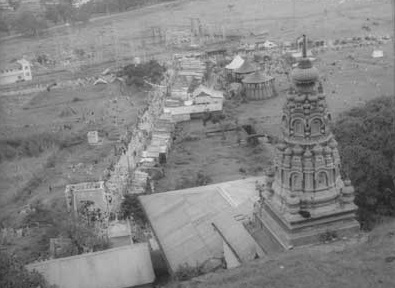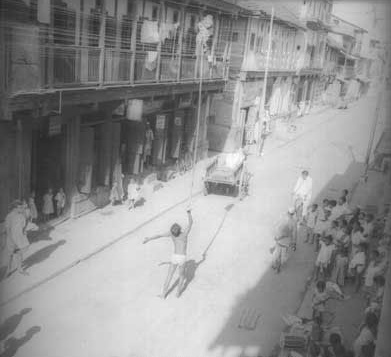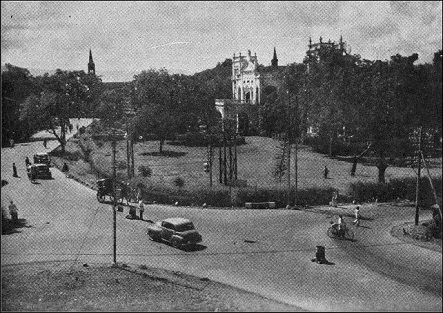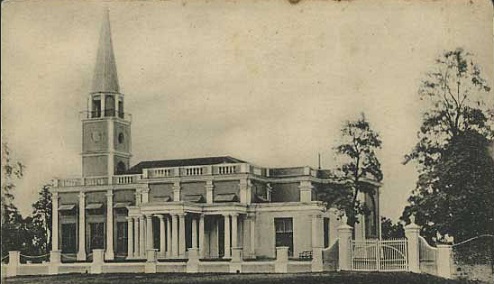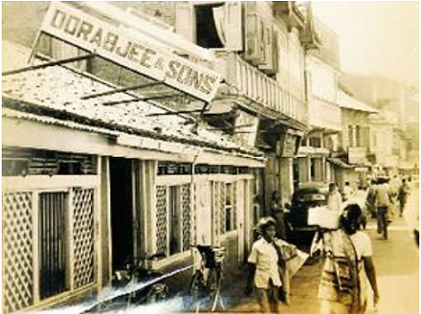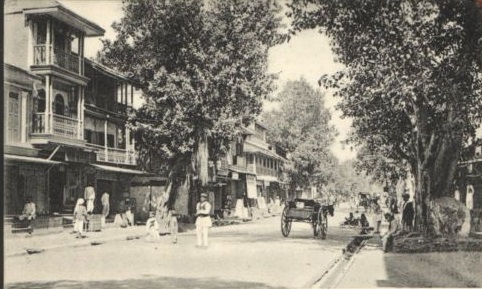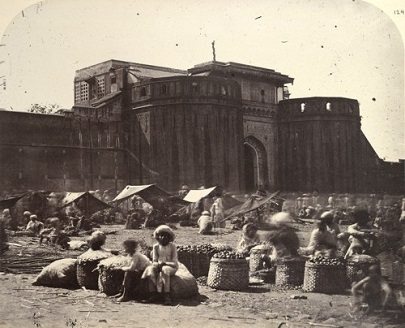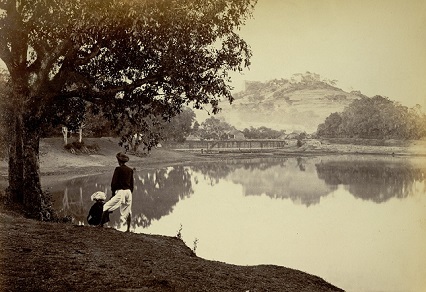Pune/ Poona City
Poona City, 1908
This section has been extracted from THE IMPERIAL GAZETTEER OF INDIA , 1908. OXFORD, AT THE CLARENDON PRESS. |
Note: National, provincial and district boundaries have changed considerably since 1908. Typically, old states, ‘divisions’ and districts have been broken into smaller units, and many tahsils upgraded to districts. Some units have since been renamed. Therefore, this article is being posted mainly for its historical value.
(Puna). Head-quarters of Poona District, Bombay, situated in 18degree 31' N. and 73degree 51' E., on the Great Indian Peninsula Railway, 119 miles south-east of Bombay, and a terminus of the Southern Mahratta Railway ; 1,850 feet above the level of the sea, and, in a straight line, about 63 miles from the coast. The name seems to be derived from the Sanskrit punyapnr, or 'cleanser,' pro- bably referring to the holy meeting of the Mutha and Mula rivers. It is the military capital of the Deccan, and from June to October the seat of the Government of Bombay.
During the last fifty years Poona has been steadily growing in size. In 1851 its population was returned at 73,209; by 1863 it was sup- posed to have risen to about 80,000. At the next three enumerations it was: (1872) 118,886, (1881) 129,751, and (1891) 161,390. In 1901 it was returned at 111,381, exclusive of 41,939 in the cantonment and suburbs; total, 153,320. Hindus numbered 122,393; Muhammadans, 18,165; Christians, 8,474; Parsis, 1,900; and Jains, 1,473.
With the heat of April and May tempered by a sea-breeze, a moderate rainfall, and strong cool winds, the climate is agreeable, but of late years it has not been reputed to be healthy. The annual rain- fall for 1891-1901 averaged 28 inches. The mean temperature in 1901 was 70; maximum 110 (in May), minimum 43 (in December). Poona has suffered severely from the plague, which first gained a foot- hold in the city in January, 1897. In 1899 the mortality rose to 125 per week, or an annual death-rate of 207 per 1,000. Severe repressive measures in 1897 failed to eradicate the epidemic.
The first mention of Poona in history seems to be in 1604, when it was granted by the Sultan of Ahmadnagar to Maloji, the grandfather of Sivaji. In 1637 the grant was conpirmed in favour of Shah j I, father of Sivaji. In 1663, during the operations conducted against Sivaji by order of Aurangzeb, the imperial viceroy Shaista Khan took possession of the open town, from which, when surprised a few days afterwards by Sivaji, he had great difficulty in making his escape. His son and most of his guard were cut to pieces, and he himself wounded. A powerful force, however, immediately reinstated the discomfited commander. In 1667 Aurangzeb restored Poona to Sivaji; but under the sway of his successor Sambhaji, it was occupied by Khan Jahan, an officer of the emperor. On the Peshwa obtaining supremacy in the Maratha confederacy, the chief seat of government was removed from Satara to Poona. In 1763 Nizam All of Hyderabad sacked the city and burned such parts of it as were not ransomed. In the struggle between the successive Peshwas and their nominal subordinates Sindhia and Holkar, Poona suffered many vicissitudes, until in 1802, by the provi- sions of the Treaty of Bassein, the Peshwa allowed a British subsi- diary force to be stationed here.
The final defeat of the Peshwa Baji Rao, and the capture of Poona in 1818, were the results of three engagements. In the battle of KIRKEE (November 5, 1817) the British forces, commanded by Colonel Burr, defeated a vastly superior force under Bapu Gokhale. The battle of Yeraoda (November 16 and 17, 1817) occurred near where the present Fitzgerald Bridge now stands, the British guns on ‘ Picket Hill ' commanding the position. The British troops were com- manded by Brigadier-General Lionel Smith. The result was the flight of the Peshwa's army and the immediate occupation of the city by the British. The third battle, that of KOREGAON (January i, 1818), was fought 2 miles distant from Loni, on the right bank of the Bhima, and 16 miles from Poona. After the deposition of the Peshwa Baji Rao II (1818), the city became the head-quarters of a British District as well as the principal cantonment in the Deccan.
The city stands on the right bank of the Mutha river. Much of the country round is barren and rocky, and to the east stretches an open plain. Not much high ground is seen to the north and west, but to the south extends a line of hills ending in the bold square rock of Sinh- garh. Close at hand, on the north, is the confluence of the streams of the Mutha and Mula ; through the heart of the city, the line of the Kharakvasla canal, and on the south the lake and temple- crowned peak of Parvati are objects of interest. The Katraj aqueduct was built by an ancient Maratha family. This duct, together with three other private aqueducts, supplies the city in ordinary years with about half the required supply of drinking-water. The other half is derived from the Mutha Right Bank Canal at three places. The main near the Parvati bank supplements the supply from the Katraj aqueduct The municipality draws from the canal about 750^000 gallons a day, for which it pays Rs, 10,000 to Government. Any amount drawn in excess of this is paid for at the rate of 3 annas per 1,000 gallons. The old water-works owe their existence to the liberality of Sir Jamsetji Jijibhoy of Bombay, who contributed Rs. 1,75,000 towards the entire cost of Rs. 2,00,000. The new water-works for the Poona cantonment and suburbs were constructed in 1873-4, and were furnished with new settling-tanks and filter-beds in 1894-5. The maximum daily consumption from these works is 1,700,000 gallons. The pumping station is situated to the east of St. Mary's Church, the power being passed from a Poncelet wheel to three centrifugal pumps on the right bank of the canal and to a Worthington water engine on the left bank. There are five settling-tanks, with a total capacity equivalent to three days' consumption, and four filter-beds with an area of 45,000 square feet. Water is pumped from the canal into the settling-tanks and thence into the filter-beds by means of centrifugal pumps. Two reservoirs supply the cantonments and suburbs, the charge for water by meter varying from 6 to 8 annas per 1,000 gallons, according as the cost of pipes and connexions is borne by the householder or not. For three or four months in the hot season very little water is available, and pumping has to be performed almost entirely by steam-power. Gardens on every side, and groves of acacia along the banks of the rivers, give much of the neighbourhood a green, well-clothed appearance.
The city proper extends along the Mutha for about 1 1/2miles in- land, varying in height from 30 to 70 feet above the river. Its length is about 2 miles from east to west, and its breadth about 1 3/4 miles, the total area being 2 1/2square miles. For police and other purposes the city is divided among eighteen wards or peths. Under the Peshwas it was divided into seven quarters, named after the days of the week. The ruined palace of the Peshwas stands in the Shanwar quarter, or Saturday ward. The palace was burned down in 1827, and all that now remains is the fortified wall. The chief streets run north and south. Though broad in parts they are all more or less crooked, none of them offering an easy carriage-way from one end to the other. From east to west the only thoroughfare is by lanes, narrow, short, and interrupted. One of these was set apart for the execution of criminals*, who, in the time of the Peshwas, were here trampled to death by elephants. Most of the houses are of more than one storey, their walls built of a framework of wood filled in with brick or mud, and with roofs of tile.
East of the city is the military station, with an area of 4 1/4 square miles and a population of 32,777. Within cantonment limits, north- wards to the Mutha- Mula river and for 2 miles along the road leading west to the cantonment of Kirkee, are the houses of the greater part of the European population. The remaining European quarter or Civil Lines was made a suburban municipality in 1884. In area it covers if square miles, and had in 1903-4 an income and expenditure of Rs. 31,000 and Rs. 33,000 respectively, the former chiefly derived from a house tax and octroi. The first Residency was built where the present Judge's house now stands, at the Sangam or junction of the MuLa and Mutha rivers. The compound included the site of the present Science College and the English burial-ground close to the present Sangam Lodge. The Resident's quarters contained five houses, besides out-offices for guard and escort parties. The entire block was destroyed on November 5, 1817, immediately upon the departure of Mr. Mountstuart Elphinstone to join the British forces drawn up for battle at Kirkee. There have been five European cemeteries open since the Maratha possession of Poona one near the old Residency, the second near the present church of St. Paul, the third in East Street, one near the rifle butts, and one on the left of the Sholapur road. A new Residency was built near the present site of St. Paul's Church in 1819, and was accidentally burnt down in 1863. The Sangam Bridge was first built on piles in 1829, at a cost of Rs. 95,000. Sir John Malcolm opened it in 1830, under the name of the Wellesley Bridge, after the Duke of Wellington. It was rebuilt with stone in 1875, at a cost of Rs. 90,000. Holkar's Bridge was built by Madhu Rao Peshwa, and so named because Holkar was accustomed to pitch his tents in its vicinity. Close by is ‘ Holkar's tomb’ so called, being a Saiva temple erected in memory of Vithoj! Holkar and his wife, who was a sail.
As a civil station, Poona is the residence of the usual District officers and the head-quarters of the Commissioner of the Central Division. It is also the monsoon head-quarters of the Bombay Government. The garrison generally consists of European and Native infantry, artillery, and cavalry. There is a branch of the Bank of Bombay.
In addition to the Peshwa's palace, already referred to, the city contains numerous palaces and temples from one to three hundred years old, of which the chief are : Belbag, built by Nana Farnavis about a century ago ; the Faraskhana, the remains of the Budhwar palace which was burnt down in 1879 ; Ganpati's temple; the new market, built by the Poona city municipality ; the temple of Omkareshwar ; the Vishrambag palace, now used as a Government high school. Other chief objects of interest, outside the Poona city municipal limits, are : the arsenal, built in 1882 ; the Bund gardens on the right bank of the Mula-Mutha river ; the Saiva caves of Bhamburda, the oldest remains in Poona ; Chatarshingi hill with a temple of a devi, where a large fair is held annually in September-October ; the Western India club ; the council hall; Government House, Ganeshkhind; the Poona gymkhana; Yeraoda Central jail, intended for all classes of prisoners, as well as for relieving the overcrowding of the several District jails ; the Sassoon Hospital ; the Jewish synagogue ; the office of the City Magistrate, formerly the jail ; the Native General Library ; the General Post and Telegraph office ; the Record office or Poona Daftar ; and the Empress Gardens at Wanowri. The total number of in-patients treated at the Sassoon Hospital in 1903-4 was 2,585, in addition to 12,110 out- patients. Other medical institutions are the Roman Catholic school hospital, the St. Margaret Hospital, St. John's Hospital, and six dispen- saries, treating annually about 40,000 patients.
The city municipality, established in 1857, had an average income during the decade ending 1901 of 3 1/2 lakhs. In 1903-4 the income was also 3! lakhs. The chief items of income are octroi (1 1/4lakhs) and conservancy tax (Rs. 39,000), while the expenditure, which amounted to 3 lakhs in 1903-4, is chiefly devoted to conservancy (1 lakh) and establishment charges (Rs. 44,000). The income and the expenditure of the cantonment fund in 1903-4 were nearly 1-8 lakhs and 1-5 lakhs respectively.
Though Poona is no longer so great a centre of trade and industry as under the Peshwas, there are still many handlooms for the weaving of fabrics of silk and cotton ; and articles of brass, copper, iron, and clay are made in the city. Throughout Western India Poona workers have earned a reputation for the manufacture of cloth, silver and gold jewellery, combs, dice, and other small articles of ivory, of fans, baskets, and trays of khas-khas grass ornamented with peacocks' feathers and beetles' wings, and of small, carefully dressed clay figures representing the natives of India. There are now several important factories in the city and its immediate vicinity. Chief of these are the gun-carriage factory * and arsenal in cantonments, and the small arms and ammuni- tion factories at Kirkee. At Dapuri there is a large brewery. In addition there are two cotton-mills, some iron and brass foundries, and a paper-mill.
Besides a female normal school, an unaided normal class for mis- tresses, and a training college for preparing teachers for vernacular and Anglo-vernacular schools, and several Government and private vernacular, Anglo-vernacular, and English schools, Poona has twelve high schools and three colleges the Deccan and Fergusson Colleges teaching up to the degrees of B.A. and first LL.B., and the College of Science with special training for civil engineers and agricultural specialists. There is a medical school attached to the Sassoon Hospital, a forest class at the College of Science, a municipal technical school, and a reformatory at Yeraoda. The total number of schools is 78 for boys with 7,205 pupils, and 4 for girls with 3,318 pupils. The city contains 2 Subordinate Judges' courts, in addition to the chief revenue, 1 The gun-carriage factory was closed in 1907.
judicial, and other public offices. Besides the purely European clubs, Poona contains the Deccan Club, to which both Europeans and natives can belong ; two native clubs, the Sarvajanik Sabha and the Deccan Sabha; and a newly opened club for ladies. The most important library is the Native General Library in Budhwar Peth.
Cafés, historic
Tracing Pune’s oldest cafes
Swasti Chatterjee,TNN | Apr 26, 2015 The Times of India
They have been landmarks. They have a century-old legacy behind them. As the fate of Mumbai's iconic Cafe Mondegar, which might shut down due to legal issues, hangs in the balance and Cafe Samovar having shut shop recently, here's to Pune's old cafes. Rustic, old-world charm and generations of serving food — they have been there and witnessed all.
Vaidya Uphar Gruha, BUDHWAR PETH - Established in: 1910
Vaidya Uphar Gruha is probably among the first five eateries in the city that sprang up in the 1900s. It was frequented by freedom fighters and artistes alike, who came to dig into the only missal serving joint in the city then. "It is probably the oldest missal serving institution in the city. Missal at that time was not accompanied by breads, but puris and was served for eight paise. In the eighties, we revised the rates for the fourth time and made it to `3. Now, it costs `45," said Deepak Joshi, fourth generation owner of the joint.. Yashwant Rao Chavan was a regular here, and so was author Pralhad Keshav Atre, who used to visit it between 1915-1917. "At a time when medicines were not as popular as today, our 'sample' was famous for curing cough and cold. We still make the kairichi daal, that was introduced by my great grandfather," he added.
Dorabjee & Sons Restaurant, CAMP - Established in: 1878
Back in the 1800s, Pune used to have only one restaurant, El Moretos, located in Camp. It was an Italian restaurant and dance bar, which could be accessed only by the British officials stationed in the city. In 1878, Sorabjee Dorabjee began a tea stall serving Irani chai, where the present restaurant stands.
"However, in six months he realised that the city had a good demand for food. So we began the restaurant here serving to both Indian and British guests. At that time, there was no trend of eating out, so the place was mostly frequented by foreigners," said Darius Dorabjee, the fourth generation member, running the restaurant. El Moretos shut, Kayani Bakery came up there in due course. However, Dorabjee & Sons still went strong. In fact they still have the menu of the 1940s, when food was priced in annas. Even the menu remains the same: mutton biryani, dhansak, patrani macchhi and other Parsi delicacies.
Poona Guest House, Laxmi road - Established in: 1935
Nanasaheb Sarpotdar, who started Poona Guest House, was a close friend of Dadasaheb Phalke. Phalke often stayed at the guest house which was used for lodging by the actors who starred in Phalke's films. "It costed 20 paise for lodging then. "Whenever Dadasaheb Phalke was in Pune, he would stay here. My great grandfather also started the restaurant, which served snacks at 2 paise. Later, actors like Dev Anand, Kishore Kumar, Dilip Kumar and Lata Mangeshkar also visited and stayed at this place," said Kishore Sarpotdar, a fourth generation member of the family.
Cafe Goodluck, deccan - Established in: 1935
It came up in the same year as the Poona Guest House. In 1932 Narayan Seth bought a small place which was later taken over by Haji Hussain Ali Yakshi. In 1935, Haji Hussain set up this food joint here which served Irani chai and bun maska. "The challenge after we took charge of the cafe was to revive the menu, which was monotonous. So we introduced the tawa recipes for the young crowd. Earlier, it used to be biryani and basic snack items," said Kasim, a part of the restaurant.
Badshahi, Tilak road - Established in: 1937
By the 1930s, the trend of lunch and dinner serving restaurants had evolved in the city. Badshahi is one of the pioneers in serving thalis. Artistes used to throng the restaurants to dig into the thalis, that were priced between 2 to 4 paise. And the menu has not changed much since. "We still serve four chapatis, two sabzis, rice and curry. We also have a special Sunday and Thursday menu. In the 70s, the price of our thali was around `15, it now costs `90," said Sadanand Chhatre, fourth generation owner of the place.
George, camp - Established in: 1936
George is a landmark in the city. It has been around for the past 79 years and there have been no changes in the menu since its inception. "Except for a few additions, we have retained whatever it used to have in the 30s. George has a legacy of its own and the biryani served here is made from the same recipe used in the 1940s," said Jawad Jawadi, who has been the restaurant's manager for 22 years.
Prabha Vishranti Gruha, Narayan Peth - Established in: 1940
It was the peak of freedom struggle in the country, when Prabha Vishranti Gruha sprang up in the city area. It served snacks to the freedom fighters who used to huddle up there to chalk out plans of driving away the British. "My great grandfather started out with our special batata wada, sabudana wada and khichadi. They were priced at 2 paise then," said Ketan Paranjpe, a fourth generation owner of the place.
Kawre Ice Cream, Laxmi Road - Established in: 1952
Since the concept of ice-cream came to the city, the Kawre Ice-cream centre has been around and so has its mastani and faluda. Sundaes were introduced in the 90s and the Peshwai and paan flavours in the early 2000s. However, Kawre still serves the same flavours that were available in the immediate years post-independence. "During the fifties, we produced as per the daily requirements and as there were no storage facilities, we had to sell everything on the same day. Also, seasonal fruits mattered to us a lot back then, since we did not get the canned fruits," said Rajiv Kawre, a third generation owner.
Bedekar Missal, Narayan Peth - Established in: 1954
Bedekar missal still serves missal on Sundays and the kairi panna that was introduced in the 50s. There are gulkand laddoos, a dish that has been carried forward by three generations along with kokum sharbats and other Maharashtrian snack items. All these items costed less than a rupee in the 60s. "Now it is around `50," said Manali Alhad Bedekar, a third generation owner.
Aviation
1919: first aeroplane lands
Atikh Rashid, May 13, 2023: The Indian Express
On the afternoon of December 21, 1919, the people of Pune (then Poona) witnessed a great novelty. That Sunday, thousands of residents saw an aeroplane in action for the first time, leaving them thrilled, mesmerised and enraptured with this flying machine – although it had the capacity to accommodate just two people.
They had read about the heroic agility of these machines in the newspaper accounts of World War I and heard of the devastation brought by aerial bombing. But it was their first encounter with the flying machine sans the menacing context of war. During the previous decade, several maharajas loyal to the British throne had bought fighter planes and gifted them to the government for use in the war that was mainly taking place in Europe.
The plane visiting Pune was Nieuport and General Company’s Nighthawk, an aircraft which was developed in Britain for military use and later modified as a commercial flyer. It was sent to India with a couple of pilots to undertake promotional flights to gauge if there was a market for aircraft in India.
It had arrived in Bombay by sea a week ago and its journey from there to Pune was also the first ‘newspaper flight’ in the country as it carried copies of the Sunday edition of the Anglo-Indian Bombay paper ‘Advocate of India’ for distribution in Pune.
As per reports, the biplane was supposed to arrive in Pune skies at 10.30 am and tens of thousands of locals, including senior officials in the administration – both British and Indian – had gathered at the Race Course to watch the then-unfamiliar leap of science.
“A large number of the chief people of Poona assembled on the racecourse before 10 o’clock, filling the grand stand and all the stands along the racecourse, while huge crowds filled the sand track and the grass track, the Sholapur Road side of the Maidan. On the opposite side (there was) a moving mass of thousands of persons. The ground was kept by the military: the traffic was looked after by the police,” described a newspaper report.
There was, however, some delay in the arrival of the plane and some anxious prominent Britons had started to leave the grounds as the temperatures began to soar when at 12.50 pm, the “shrieks and shouts rented the air and the Nighthawk was seen careering over Poona at top speed”.
In the evening, the crowd grew even stronger to witness the air show. “The airmen got going at 5.20 pm and for twenty minutes they thrilled the spectators with their daring and intrepid serves, spirals, climbs and drives, not to mention his wonderful feats of looping the loop,” wrote the paper.
The Nighthawk in India
The Nieuport Nighthawk was originally developed for the British Royal Air Force (RAF) towards the end of the war. It did not enter large-scale service though, reportedly owing to unreliable engines which “got so hot they sometimes charred the propellers!”. The two-seater was designed by H P Folland and powered by one 320 HP ABC Dragonfly engine with a span of 28 ft and length of 18 ft, with a capacity to fly at 150 mph and rise to 2,000 feet in 17 minutes.
The firm had sent Captain R S Carrol and Lieutenant J H James to India on a promotion mission sans the aircraft. After landing in Bombay in September 1919, the duo realised that they would need the aircraft if they were to achieve any marketing success. Upon Captain Carrol’s request, a Nighthawk arrived at Bombay dock aboard SS Gandara.
The Nighthawk was assembled in record time, and the next day it rose from the Willingdon Club grounds to court the Bombay sky. The plane enthralled the spectators with hair-raising zooms, dives, loops and spins before returning to the dock after covering Bandra, Oval, Fort and Apollo Bunder.
The nationalist press was not as thrilled as the promotional event was a part of the ‘Peace Celebrations’ organised by the British government to mark the end of the war and ‘reestablishment of peace in Europe’ and was opposed by the Indian National Congress.
The promotions by Captain Carrol and Lieutenant James did not go in vain, however, as the Nighthawk was sold to an Indian buyer in September 1920.
Flight operations in Pune
It would take two more decades for an aircraft to become a common sight in Pune. This happened after a base of the Royal Indian Air Force (RIAF) came up at Lohegaon to protect Bombay and other important areas in the vicinity. This base remained busy throughout World War II with several squadrons operating from here. This later became the Indian Air Force station and then a civil enclave for commercial operations.
“The end of WWII gave a real fillip to the civil aviation industry as surplus aircraft manufactured for defence purposes – especially those for transport of troops – were modified and sold for civil usage throughout the world,” said Dhairyashil Vandekar, aviation expert.
In 1953, when the Indian government nationalised the civil aviation sector and floated Indian Airlines for domestic commercial operations, some scheduled operations started from Lohegaon’s civil enclave connecting it to Bombay and Belgaum. The operations remained inconsistent for the first decade – being shut for years in between – despite high demand. Civil operations stabilised only after 1965 and have only grown since then.
Kotwal Chawdi
Nght-curfew: 1765 - 1852
Abhijit Atre, When a night curfew spanned 87 years, July 15, 2020: The Times of India

From: Abhijit Atre, When a night curfew spanned 87 years, July 15, 2020: The Times of India
Kotwal Chawdi, from where the kotwals prevented people of Pune from stepping out at night PUNE: It's been over three months since you sat at your favourite table in the corner of a restaurant, scrambling to order before the counter closed. Curbs on after-dark movement in Pune that began on March 22 have gone on for nearly 100 days. Stretched as it has been, the restriction is still nowhere near the longest period of ‘night curfew’ imposed in the city lasting 87 years from 1765 to 1852.
The current ban on night movement, between 9pm and 5am, is the second longest in the history of Pune, according to history scholar Mandar Lawate. “Night curfew during the 1965 India-Pakistan war lasted for 10 days,” he said.
Cut to an incident that took place when night curfew was in place in August 1791. “The cannon at Bhamburda (now Shiva jinagar) check-post was fired at 9pm signalling a restriction (similar to the current night curfew) on the movement of people on the streets till the next morning. Unaware, 34 Brahmins, who had arrived in Pune from a city in the south, were roaming on the streets. They were arrested by the security guards and locked up in a small and congested room. When the doors were opened the next day, 21 of them had suffocated to death,” wrote noted history scholar, the late M P Mangudkar, in his Marathi book 'Pune Nagarsanstha Shatabdi Grantha'.
The book, an official documentation of the administrative history of Pune, was commissioned and published by the Pune Municipal Corporation in 1960. Mangudkar said news of their deaths greatly angered the citizens who took out a protest march to the residence of Ghashiram Kotwal, then Pune's security chief. “Ghashiram ran to the house of the Peshwa and begged for his intervention. However, he was handed over to the mob which stoned him to death on August 31, 1791,” he wrote in his book.
The chilling incident was first documented by Sir Charles Malet, a British officer who was visiting Pune in August 1791, in his despatches to London. In 1972, noted playwright Vijay Tendulkar penned the powerful political satire 'Ghashiram Kotwal' based on this incident.
According to Mangudkar, the restriction on night movement was not Ghashiram’s idea, though he took it too far. Madhavrao Peshwa of the Maratha empire felt the need to set up an independent security agency to guard the city and introduced the system of kotwals in 1764, the author wrote. In 1765, the first kotwal or police chief of Pune, Balaji Narayan Ketkar, started the practice of night patrol and imposed restrictions on the movement of people during the night hours. Subsequent kotwals framed a series of rules, including making travel passes mandatory for night travel, and collection of fines from those without a pass.
“Except during the tenure of Ghashiram, who was accused of high-handedness, most Punekars were happy with the kotwal system as it helped curb crime in the city. Two centuries ago, the dine-out culture and socialising avenues were limited,” history scholar Lawate told TOI. So much so, that over the years, people became so used to being indoors post sunset that when the British in 1850 proposed lifting of these restrictions, they resisted, arguing that it may lead to thefts across the city, he said. “It took two years for the British to convince the citizens and get the restrictions removed in 1852,” Lawate added.
Pune has undergone a dramatic change from what it was two centuries ago. The historic Kotwal Chawdi, the last footprint of the kotwal era, located 100m from the junction crossing Laxmi Road and Shiva ji Road, faded into history when it was demolished by the Pune Municipal Corporation to widen the road in 1995. On that exact spot vacated by Kotwal Chawdi stands the Dagdusheth Halwai Ganpati pandal, which is visited by lakhs of citizens, particularly during the late-night hours when it is brightly illuminated, during the ten-day Ganeshotsav.
The place that was used for 87 years to prevent Punekars from stepping out during the nocturnal hours, rather ironically, now sees the largest footfall at night during the festival.
Shaniwarwada
The Times of India, Oct 9, 2011
Once the seat of power of the Peshwas, is surrounded by hundreds of old dilapidated wadas (houses). Residents say they are in shambles and in need of reconstruction. But repairs would bring entire structures crashing down. Some 150 old properties are affected by stringent ASI norms. Says Sham Dhawale, an executive engineer at Pune Municipal Corporation, “At Shaniwarwada, new constructions are banned within 100m, while in another 200m radius restricted development is allowed.” – Radheshyam Jadhav
